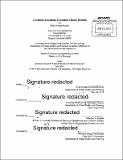Location, location, location choice models
Author(s)
Posada Mariño, Pablo
DownloadFull printable version (13.91Mb)
Other Contributors
Massachusetts Institute of Technology. Department of Urban Studies and Planning.
Advisor
P. Christopher Zegras.
Terms of use
Metadata
Show full item recordAbstract
Cities are, now more than ever before, the main centers of population and production. The growing demand for limited urban space is increasing urban complexity and magnifying both positive and negative externalities of urban agglomeration: increasing productivity, innovation, and social interaction, but also exacerbating living costs, pollution, inequality, congestion, etc. In order to build sustainable cities and have a net positive balance of urban externalities, we need to better understand the motivations of the different agents competing in the race for urban space. Location choice models can help to shine a light on these motivations by providing insights on agents' location preferences. They are also the building blocks of more comprehensive urban models and simulations that can help navigate urban complexity. This thesis explores location choice models for homeowner households and firms in Greater Boston. Specific research questions that these models can help answer include: How do residential location preferences vary with life cycles? What industries value clustering the most? These topics are important given (1) forecasted demographic changes, specifically the aging of the baby-boomers, and (2) the continuing move from a manufacturing-based economy to a service and knowledge-based economy. These changes in population and economy will likely require a change in housing stock in order to better match supply with demand, and changes in the stock of commercial space in order to continue boosting the firms that drive the economy of the region. The thesis also explores the data-related uncertainty of these models (how model estimation changes with different data sources) as well as their temporal transferability (how do preferences change over time). The location choice analysis for households suggests that income has a bigger impact on willingness to pay for location attributes than age of the head of the household or household size. The firm analysis indicates that firms in the professional service and health and education service sector place more value on proximity to jobs in the same industry and density than firms in other sectors. These preferences have strengthened over time. An in-depth analysis, such as the one presented in this thesis, of what city agents look for in a location can, and should, inform planning policies and intervention in order to better match location preferences with opportunities.
Description
Thesis: M.C.P., Massachusetts Institute of Technology, Department of Urban Studies and Planning, 2015. Cataloged from PDF version of thesis. Includes bibliographical references (pages 109-112).
Date issued
2015Department
Massachusetts Institute of Technology. Department of Urban Studies and PlanningPublisher
Massachusetts Institute of Technology
Keywords
Urban Studies and Planning.